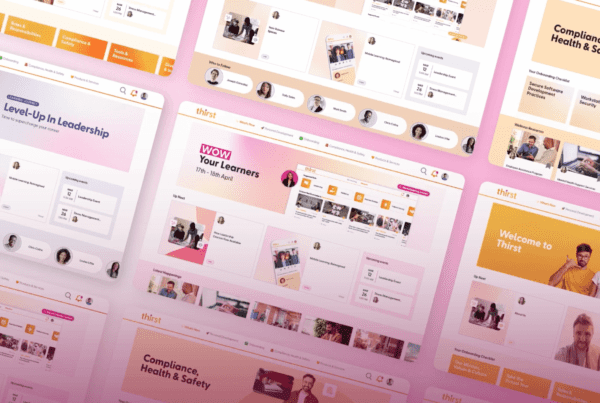If your company is experiencing rapid growth, then you’re probably in the process of recruiting multiple new members of staff.
However, if you want to ensure they’re able to do their jobs as effectively as possible – you’ll need to ensure they are onboarded quickly and efficiently. Find out how to do exactly that in this guide from the Thirst team… 👇👇👇
What is onboarding?
For different people, onboarding has different meanings and connotations. Here at Thirst, we define onboarding as:
“The process by which new members of staff acquire the knowledge, skills and behaviours that allows them to carry out their jobs to the best of their abilities”.
Also known as ‘organisational socialisation’, the onboarding process will typically cover myriad topics, from relatively minor points such as familiarisation with the office building, and provision of a laptop. 🏢💻
Onboarding also covers more substantial elements such as familiarisation with company policies, the signing of the contract of employment, issue of the employee handbook, compliance training etc. 📝🖊️
Whilst that might not sound like a lot – research from software provider Oak Engage has discovered that the average onboarding process ‘expects a new employee to complete 54 activities during their onboarding process’. 🤯🤯
In other words, there’s far more to onboarding than many people realise! 😲
A good employee onboarding process can take anywhere between six weeks and three months. The length of the onboarding process will tend to vary based on the individual job role and the organisation. ⏳
An important point to note is that the onboarding process has changed considerably in recent years.
In the pre-COVID-19 era, onboarding would take place entirely in the workplace, with a tour of the office, various face-to-face meetings with HR and colleagues, an induction plan and the occasional check-up meeting.
With the rise of hybrid working and fully-remote jobs, the onboarding process has had to evolve accordingly, with many elements shifting to digital e.g. onboard via video calls. 📺
The benefits of a great employee onboarding process
Is onboarding really that essential?! At Thirst, we say YES. 😎
Think of that time-worn saying, “first impressions matter”. The onboarding process is where most businesses make their first impression to a new employee – so, it needs to be good! 👍👍
Given that we’re still in the midst of the ‘great resignation’ and the battle for talent is as fierce as ever, it’s crucial that your business has a great onboarding process, or else you’ll quickly find that your employee churn increases, losing you valuable staff members. 🏃♀️💨
That’s not the only benefit of a great onboarding process, though. Below are some of the benefits your business can reap with quality onboarding. ⏩⏩
Improved productivity
If you just throw an employee in at the deep end and don’t provide them with any support, what do you think will happen? They’ll (metaphorically) drown! 🏊♂️
Provide new employees with all the information they require in relation to their role, and you’ll find that they’ll be far more productive from day one. 💫⭐
Even seemingly minor things can make a big difference. For example, if you fail to let staff members know about things like office etiquette, they can struggle to settle in and will – as a result – be less – productive. 😔
Plus, don’t always assume that someone will just ask questions if they don’t know something. Some employees will be too shy to ask questions – and as a result, may not be as fully productive as they could be. 🥺👉👈
Improved revenue
Related to the above point about improved productivity, it naturally follows that a great onboarding process will also result in improved company revenues. 📈
And, when we say improved, we mean it! 🤑
As per research carried out by software provider Oak Engage, companies that have a quality, structured onboarding process experience 60% year-on-year improvements in revenue. 💸💸
That’s not to be sniffed at! 👃
Improved employee/manager relationships
Another major benefit of a quality onboarding process is better relationships between new employees and their managers. 🤝
Ensure that your onboarding journey factors in regular catch-up meetings with the employee’s manager, and you’ll find that the new starter feels more empowered and comfortable asking questions – developing better employee/manager relationships.
Win, win! 🏅
Less employee churn
This may sound like an obvious benefit, but if you provide new employees with comprehensive support and information as part of their onboarding, they’re less likely to down tools and leave! ⚒️
Don’t just take our word on this point, though. There’s a whole heap of empirical evidence about the correlation between a good onboarding process and employee retention. 🤓📚
According to a study conducted by research and analyst firm Brandon Hall Group, a quality onboarding process can improve employee retention by a staggering 82%. We’re sure you’ll agree that that’s quite a staggering figure. 💪💪
When you consider that the cost of recruiting a new employee can cost 20% to 30% of that employee’s salary, it’s well worth making the effort to craft a truly stand-out onboarding process. 💯🔥
Improved company culture
This is perhaps a less tangible benefit than the others listed here, but it’s still a benefit.
A great onboarding process will not only help new starters to understand a company’s culture, but to become part of it quickly. 🙋🤗
Given that – according to a survey conducted by employee engagement platform People Element – 20% of new starters say they weren’t made to feel welcome at their last job, it’s vital that employees are inducted to a company’s culture as part of their onboarding process.
Onboarding best practices
As you can see, it’s well worth providing new employees with a great onboarding process. There are plenty of benefits to doing so!
But, what does a great onboarding process actually look like? How do you go about actually onboarding employees in the best possible way? 🤔💭
The Thirst team has set out how to do exactly that below. We’ve covered crucial elements including best practices, and tips on how to make the process quick, accurate and smooth.
1. Set clear onboarding goals
What exactly do you – and the new starter – want to get out of the onboarding process?
Before you do anything else, you should answer these questions and set clear goals and targets for the onboarding process. 🎯🎯
These targets can include both qualitative and quantitative data points. For example, you can set qualitative measures – such as the new starter feeling more comfortable at the company by the end of the onboarding process. 😃
Likewise, quantitative measures could include the number of people across the company that the new starter has been introduced to. 🔢
Naturally, if you’re going to set onboarding goals, then you need to check in on the new starter’s progress towards these goals throughout their onboarding. Should you find they are struggling with any aspect of their onboarding, you can reiterate the targets and adapt the process accordingly. 💁🏻💁🏻
2. Engage with new starters ahead of their start date
If a new employee is starting with your company on the 5th May, don’t wait until the 4th of May before you start engaging with them! 📱📱
From the second they are offered, and accept, a position with your company, your onboarding efforts should be underway.
Should you go silent, in the worst-case scenario you may very well find that your new employee accepts an offer from a competitor. Even if they don’t, you won’t be making a very good first impression. As we said earlier, first impressions really do count! 🤓
Keep in touch with them via email and phone – and keep them updated with developments in the company. Let them know about other new starters. Keep them up to speed on upcoming company socials. Let them know who their buddy is going to be.
The more you can stay engaged with a new employee prior to their start date, the smoother the rest of their onboarding process will be. 😁🛝🧈
3. Immerse new starters in your company culture
Every company is different. Whether they realise it or not, a company has a culture – and that culture is made up in large part by the employees.
It will make your onboarding process far more effective if you can not only identify your company culture, but also find ways in which you can immerse new employees in that culture. 🫠🫠
You can do this by setting ‘culture learning targets’, that is:
- Invite the new starter to meet key people within the organisation (e.g. subject-matter experts, social committee members) – not just senior leaders! 🤝
- Allow new starters to drop into meetings and simply observe. They’ll be able to pick up on how people interact and other social cues that aren’t always immediately obvious. 🔎
- Ensure new starters are invited to lunch, socials, and other informal events where cultural bonding takes place. 🥡😋
Whilst you can quantify these cultural learning targets, it’s important not to standardise and formalise the process too much. Allow for some flex – after all, an impromptu trip to lunch with your new colleagues isn’t always a pre-planned event!
4. Assign a buddy
One of the most effective ways you can onboard employees quickly and effectively is to assign them a buddy. 👬
Think of a buddy as being like the new starter’s ‘tour guide’, showing them all the various bits of the company they need to know about.
And, don’t think it all needs to be about the ‘big stuff’.
A buddy that shows a new starter how to open that door that’s really awkward, or where to find the printer paper, makes a bigger difference than many people realise. It means new starters don’t have to ‘sweat the small stuff’ and can concentrate on settling in. 🥵💧
Buddies also offer an alternative avenue for questions that a new starter might not want to ask their line manager. All in all, a buddy – provided they complement the nature of the new starter – are a fantastic way of easing the onboarding process. 😎
Tip – some companies pair new starters with multiple buddies. This is a particularly good tactic if a new starter is going to be working across multiple departments or teams.
5. Nail the small details
Sure, you’ve got to ensure that crucial things like the contract of employment, employee handbook and compliance training are boxed off as part of the onboarding process.
But – as our point above about buddies highlights – make sure that you’re addressing the small details, no matter how trivial they may seem. 🔍
It’s best to assume that a new starter knows nothing about your company. Whether it’s how to commute to the office, or whether they need to bring their own lunch – try to address even the most minor of details as part of the onboarding process. 🤷♀️
Sure, some new starters may think you’re going overboard, but there are always those who appreciate being told about even the most minor of details.
How to measure the effectiveness of your onboarding process
If you’re going to be making all of this effort to create an awesome onboarding process, you (and undoubtedly your boss/board of directors) are going to want to know if it’s having a positive impact. 📊
Use employee engagement surveys
For new and existing employees alike, it can be enormously helpful to ask them to complete engagement surveys.
Surveys are an invaluable way of capturing qualitative feedback about your onboarding process. 📤
Sure, you may have quantitative data – such as how many people have been onboarding and the steps they passed through as part of the process – but that kind of data won’t tell you whether they actually enjoyed the onboarding process or found it useful. 🤐
Employee engagement surveys solve that issue.
The best examples of employee engagement surveys allow people to answer questions on a scale of one to 10 (providing quantitative data), as well as follow-up questions that ask them why they assigned a certain numerical score (this provides the qualitative data). 📨
One to ones
Another way in which you can measure the effectiveness of your onboarding process is to conduct one-to-one interviews with employees. 👨💼👨🏻💼
These interviews are particularly useful when they are carried out at different stages of the employee journey. For example, have a one-to-one with an employee who has just completed the onboarding process. Follow this up with a second one-to-one six months later and see if they still found the onboarding process effective.
One-to-one interviews – especially when paced out like this – can yield insights that you wouldn’t necessarily get from a survey. 🤔
Conduct exit interviews
Although you hope that your onboarding process will lead to an entirely happy workforce, you’ll still find that some employees leave from time to time. ⏩
And, one of the reasons they may be leaving, is because they had a poor onboarding process and never really felt like they ‘gelled’ with the company. 😥
You’ll only find that out if you ask onboarding-specific questions during exit interviews.
Ask leavers about their first impressions of the company, how they found the onboarding process, what they would do to improve it, etc.
It’s almost certain that you’ll garner some insights which can not only be used to assess the performance of your onboarding process, but tangibly improve it. 📋
Thirst: the key to a happy workforce
Onboarding new employees is only the first step in creating and sustaining a happy, productive workforce.
Ongoing learning and professional development should be a core part of your learning and development efforts – and Thirst can sit at the heart of this. 👍
As an AI-powered learning platform, Thirst will help you create the ultimate personalised learner-led pathways that help you retain the very best talent in your business. 👇👇👇
Try Thirst for yourself with a free demo today.
For more e-learning insights, resources and information, read the Thirst blog…
7 Trends That Will Shape Learning and Development in 2023: What L&D Professionals Need to Know | What Is Personalised Learning? And How Can It Take Your L&D to the Next Level? | 7 Ways to Identify Knowledge & Skills Gaps in Your Workforce






